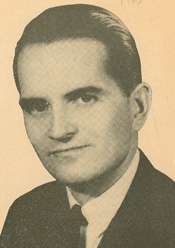John Jarman
| John Henry Jarman II | |
|---|---|
 | |
| Member of the U.S. House of Representatives from Oklahoma's 5th district | |
|
In office January 3, 1951 – January 3, 1977 | |
| Preceded by | A.S. Mike Monroney |
| Succeeded by | Mickey Edwards |
| Member of the Oklahoma Senate | |
|
In office 1949-1950 | |
| Member of the Oklahoma House of Representatives | |
|
In office 1947-1948 | |
| Personal details | |
| Born |
July 17, 1915 Sallisaw, Oklahoma |
| Died | January 15, 1982 (aged 66) |
| Political party |
Democratic Party (until 1975) Republican Party (1975–1982) |
| Spouse(s) | Ruth Virginia Bewley |
| Children |
John Henry (Jay) Jarman III Susan Jarman Steve Jarman |
| Alma mater |
Yale University Harvard Law School |
| Religion | Protestant |
| Military service | |
| Allegiance |
|
| Service/branch |
|
| Years of service | 1942-1945 |
| Unit | Security Intelligence Corps |
| Battles/wars | World War II |
John Jarman (July 17, 1915 – January 15, 1982) was a member of the United States House of Representatives from Oklahoma for 26 years from 1951 to 1977.
Early life and career
Jarman was born in Sallisaw, Oklahoma and graduated from Yale University in 1937 and from Harvard Law School in 1941. Jarman was admitted to the bar in 1941 and began his law practice in Oklahoma City. Jarman enlisted in the United States Army in January, 1942 (about a month after the Japanese Attack on Pearl Harbor). He served in the Security Intelligence Corps during World War II and was eventually discharged from military service in December, 1945. He was married to Ruth Virginia Bewley and had three children, John Henry Jarman III, Susan Jarman and Steve Jarman.
Jarman was later elected to the Oklahoma House of Representatives and then later to the Oklahoma State Senate; Jarman was elected to the U.S. House of Representatives in 1950 as a Democrat.
Jarman switches parties
Jarman was reelected 11 times without serious difficulty. However, by the mid-1970s, the Oklahoma City area started trending more Republican. As proof of this, in 1974, Jarman was nearly defeated by Republican newcomer Mickey Edwards in a year when Republicans were severely punished for the Watergate Scandal.
On January 23, 1975, Jarman switched parties and became a Republican in protest of the removals of Felix Edward Hébert, Wright Patman and William R. Poage from their committee chairmanships.[1] Jarman claimed that the Democratic Party Caucus had changed over the years and that certain elements of the Caucus "force their liberal views on this Congress and on this country by nullifying the seniority system and punishing those who do not adhere to the liberal party line as laid down by the caucus."[1]
He did not run for reelection in 1976. Edwards won the seat, and the district has been in Republican hands ever since.
Retirement and death
Jarman declined to seek re-election to the House in 1976.[2] After leaving Congress, he decided to resume his practice of law in Oklahoma City, where he remained until his death there on January 15, 1982.[3] Jarman was laid to rest at Rose Hill Burial Park. Jarman spent much of his later life in Mexico and with his children and their families in Hawaii, Pennsylvania and Colorado. He loved animals - especially small dogs, horseback riding, the rough wilderness of Wyoming, Oklahoma and Colorado.
See also
References
- 1 2 "Congressman leaves Democratic Party". Lodi News-Sentinel. Lodi, California: Google News Archives. United Press International. January 24, 1975. p. 9.
- ↑ "Albert's Top Aide Loses In Sooner Primary Bid". The News and Courier. Charleston, South Carolina: Google News Archive. Associated Press. September 23, 1976. p. 11.
- ↑ "People In The News". Eugene Register-Guard. Eugene, Oregon: Google News Archive. January 18, 1982. p. 14F.
External links
- United States Congress. "John Jarman (id: J000057)". Biographical Directory of the United States Congress.
- John Jarman at Find a Grave
| United States House of Representatives | ||
|---|---|---|
| Preceded by Mike Monroney |
Member of the U.S. House of Representatives from Oklahoma's 5th congressional district 1951-1977 |
Succeeded by Mickey Edwards |

